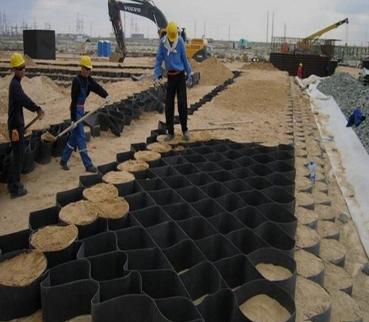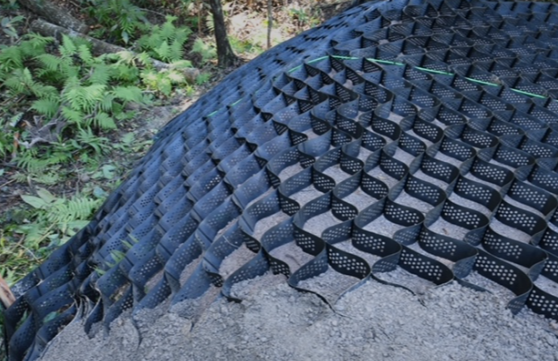- Understanding the Role of Geomembrane Liners in Waste Management
- Innovations in Geomembrane Liners for Water Management
- Geomembrane Liners: A Comprehensive Guide
- The Future of Geomembrane Liners in Civil Engineering
- Geomembrane Liners: Enhancing Landfill Stability
Manager:
WhatsApp:+86 177 0135 2670
Tel:+86 177 0135 2670
Email:marketing@okorder.com
Address:3rd Floor, No.2 Building, No.1 Sanlihe Road
What are the disadvantages of geocells?
Geocell slope protection has gained significant attention in civil engineering for its effectiveness in stabilizing slopes and preventing erosion. These innovative cellular confinement systems consist of interconnected cells filled with soil, creating a reinforced structure that distributes loads and enhances soil stability. While geocells offer numerous benefits, such as cost-effectiveness and ease of installation, it's essential to acknowledge their limitations and potential drawbacks to make informed decisions in slope protection projects.

1. Limited Durability
One of the primary disadvantages of geocells in slope protection is their limited durability in certain environmental conditions. While geocells are typically made from high-density polyethylene (HDPE) or other durable materials, prolonged exposure to ultraviolet (UV) radiation, extreme temperatures, and chemical agents can degrade the material over time. This degradation may compromise the structural integrity of the geocells, reducing their effectiveness in stabilizing slopes and necessitating premature replacement or maintenance.
2. Environmental Concerns
Despite their effectiveness in mitigating soil erosion and stabilizing slopes, geocells raise environmental concerns due to their non-biodegradable nature. As geocells degrade over time, they can release microplastics and other harmful substances into the surrounding soil and water, potentially impacting ecosystems and wildlife. Additionally, the manufacturing process of geocells involves the use of fossil fuels and other non-renewable resources, contributing to carbon emissions and environmental degradation.
3. Soil Compatibility Issues
Another disadvantage of geocells in slope protection is their compatibility with different types of soil. While geocells can enhance the stability of cohesive soils, such as clay and silt, they may not be as effective in stabilizing granular soils, such as sand and gravel. In cohesive soils, geocells provide confinement and lateral support, preventing soil erosion and promoting vegetation growth. However, in granular soils, the interlocking mechanism of geocells may be less effective, leading to inadequate slope stabilization and potential failure.
4. Maintenance Requirements
Like any other slope protection system, geocells require regular maintenance to ensure their long-term performance and effectiveness. Over time, vegetation growth, sediment accumulation, and external factors such as rainfall and seismic activity can affect the integrity of geocells and compromise their ability to stabilize slopes. Routine inspections and maintenance activities, such as vegetation management, sediment removal, and repairs to damaged geocells, are essential to mitigate potential risks and prolong the service life of the slope protection geocell system.
5. Limited Load-Bearing Capacity
While geocells can effectively distribute loads and enhance soil stability in slope protection applications, they have a limited load-bearing capacity compared to traditional retaining structures, such as concrete walls and gabion baskets. In high-load scenarios, such as areas with heavy traffic or industrial activities, geocells may not provide sufficient support to withstand the applied loads, leading to deformation or failure of the slope protection system. In such cases, engineers may need to incorporate additional reinforcement or consider alternative slope protection measures to ensure adequate stability and safety.
6. Installation Challenges
The installation of geocell slope protection systems can pose challenges in certain terrain and environmental conditions. In steep or rugged slopes, accessing the site and maneuvering heavy equipment for installation can be difficult and costly. Additionally, adverse weather conditions, such as heavy rainfall or freezing temperatures, can delay the installation process and affect the quality of the finished slope protection system. Proper planning, site preparation, and coordination with experienced contractors are essential to overcome installation challenges and ensure the successful implementation of geocell slope protection projects.

Conclusion
While geocells offer numerous advantages in slope protection applications, including cost-effectiveness, ease of installation, and effectiveness in stabilizing slopes, they also have several disadvantages that need to be considered. These include limited durability, environmental concerns, soil compatibility issues, maintenance requirements, limited load-bearing capacity, and installation challenges. By understanding these drawbacks and addressing them through proper design, construction, and maintenance practices, engineers can maximize the benefits of geocell slope protection while minimizing potential risks and ensuring long-term stability and sustainability of slope protection projects."
- Previous:Is Geocell worth it?
- Next:Who is the owner of Geocell?






